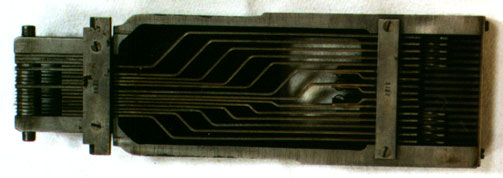A Monotype Stop Bar Case

A stopbar is a removable metal case that can be attached to a Monotype keyboard. The case consists of (usually) 15 bars (more correctly called unit rack stop bars). These provide the keyboard mechanism with the unit value of each row of characters (matrices) in a matrix case. Matrices are laid out as a grid of 15 (or 16) rows and 15 (or 17) columns, with all the characters within the one row having the same unit value (width). The layout of the matrices can vary between faces, depending upon the design of the characters, with more or less of any one width being required. Sometimes, more than one row is needed for a particular unit width, eg the 9 unit rows (corresponding to an en width), and thus different faces may need different arangements of the bars in the stop bar case. The layout can also vary to accommodate differing numbers of characters, for example whether or not a full alphabet of upper and lower case characters in both roman and/or italic and/or bold, plus an alphabet of small capitals, plus figures and punctuation, and/or fractions, accents, etc.
- Matrix case layouts can be for
- 2A: Two alphabets, ie one upper and lower case (usually large point sizes, ie large composition matrices)
- 4A: Four alphabets: eg roman and italic, or roman and bold. For Spartan and Plate Gothic, etc, it is four sizes of upper case.
- 5A: Five alphabets, eg roman upper, lower, small caps, and italic or bold upper and lower case
- 6A.Six alphabets, eg upper and lower in roman, bold and italic
- 7A: Seven alphabets, eg roman upper, small caps, and lower and bold upper and lower and italic upper and lower case.
- Matrix cases can be:
- 15x15, ie 15 rows with 15 matrices per row. This was the original configuration, holding 225 characters (some of which are the requisite em, en, etc space characters). Most of the low numbered stopbars relate to this configuration, although eg S5 can be used with all three sizes of case for some typefaces.
- 15x17. Two extra columns were introduced into the matrix case in 1925, but there were still only 15 rows.
- 16x17 (HMN). By the 1930s a sixteenth row could be added for certain specialist usage (eg Maths), but this was not part of the normal provision. The stopbar needed an extra bar.
- 16x17 (unit shift). A general 16th row system was introduced in 1963 with the use of unit shift. Although this had an extra row in the matrix case, it only needed the usual 15 bars in the stopbar, and 15 positions on the wedge. The extra row was a virtual row, as far as the caster mechanism was concerned, and the shift of unit value could be applied to any particular row, apart from the top one. This allowed a much greater flexibility in designing layouts, and for example considerably more faces were now able to use the S5 stopbar.
Apart from differences in size of matrix case, or number of alphabets required, matrix case layouts can be specific to the needs of a particular printer, who might want additional characters in say Greek, or Maths, or certain accents, or who might want certain characters cast slighly narrower or wider than usual. Thus a given stopbar might cater for just one typeface, or several different typefaces, and conversely, any given typeface might use several different stopbars, for various specific purposes.
In use, when characters are typed on the keyboard, the width of each character is registered on a unit wheel using the value given by the stopbar. This width is then shown on an em rack, which has a scale that shows the total width of line of characters and spaces so far typed, and the remaining width available in the particular line. At the same time, each word space is registered on a justifying scale, that slowly diminishes the width of the word space so as to keep a justified right hand margin. Thus the combination of wheel and rack indicate the amount of remaining space on the line being typed, and the potential inter-word space width.
Very many faces can use the arrangement of bars in the standard stop bar case, S5, and thus do not require a change of case. However, other faces do require a change, although the one case will cover most of the available sizes of type. Sizes above 12pt often require different cases, and in a few instances, such as with Caslon, it can be different for each size of type. Typewriter faces, on the other hand, have a special case that has no bars in it at all, as of course, every character is the same width.
Now go to
List of UK and US stopbars and unit values
List of UK stopbars and their typefaces
More about Monotype
or go to
Alembic Home Page

The Alembic Press
A Fine Press creating and printing limited edition books by traditional letterpress.
This page was written by David Bolton and last updated 5 March 2003.

